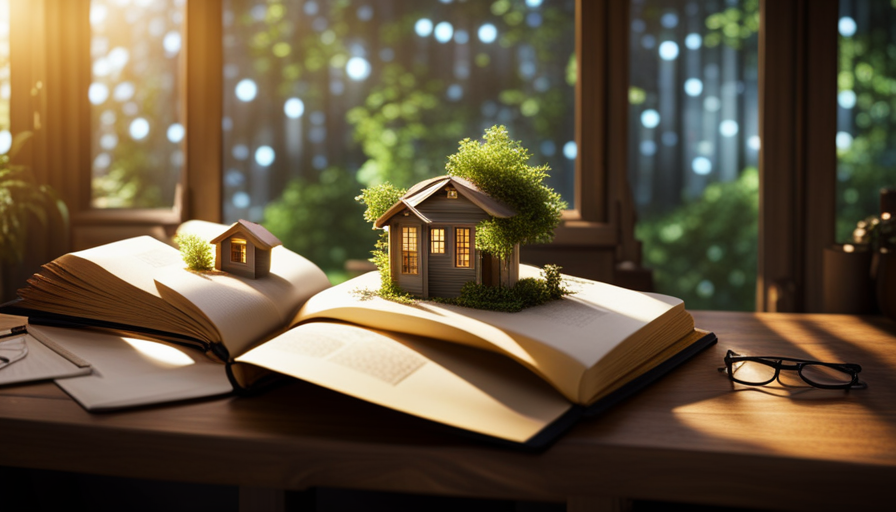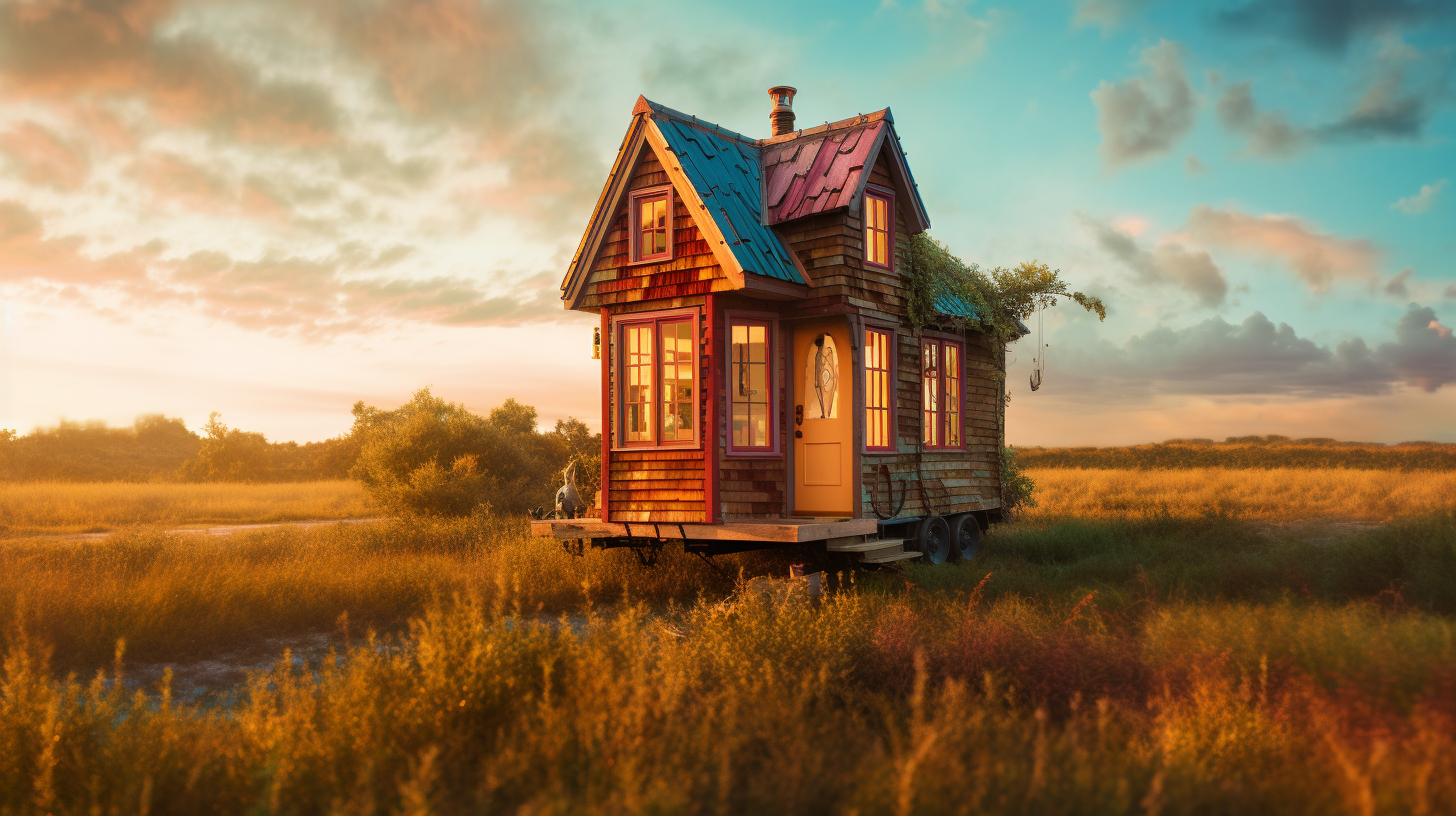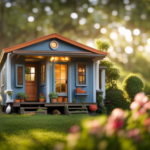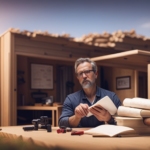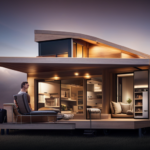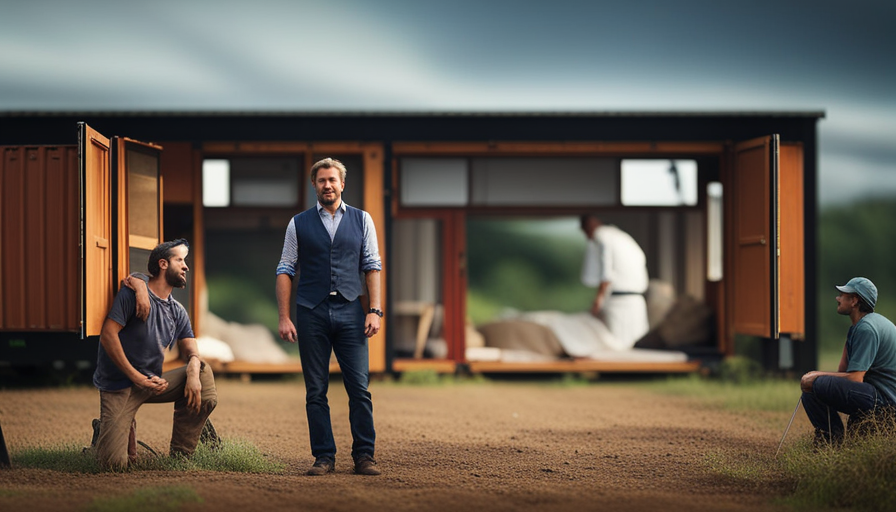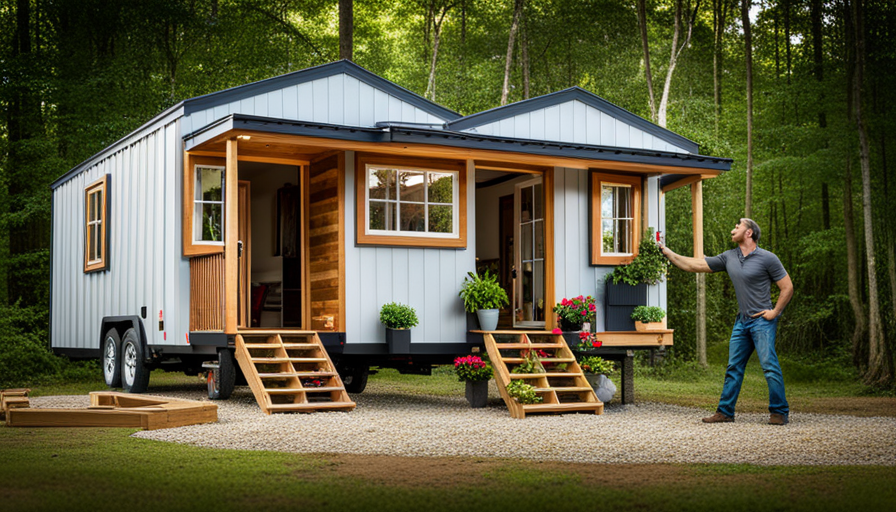Out of the many books on home renovation, one stands out as a valuable resource. This particular book is a guide to creating your own tiny house.
Like a trusted guide leading you through a dense forest, this book is a beacon of knowledge, illuminating the path to building your dream home.
Imagine stepping into a world where every square inch of space is carefully crafted and utilized, where functionality meets style in the most ingenious ways. This book is your ticket to that world, offering a step-by-step guide on how to design and build your own tiny house.
From the initial planning stages to the final finishing touches, this book leaves no stone unturned. It dives into the nitty-gritty details of off-grid living, sustainable systems, and budget-friendly solutions, ensuring that you have all the tools and knowledge necessary to bring your tiny house dreams to life.
So, if you’re ready to embark on a journey of creativity, resourcefulness, and self-sufficiency, grab a copy of the best how to build tiny house book and let the adventure begin.
Key Takeaways
- Step-by-step guide for designing and building a tiny house
- Maximizing natural light and utilizing smart storage solutions in tiny house design
- Incorporating solar power and rainwater harvesting for off-grid living
- Importance of choosing the right location and materials for a DIY tiny house
The Tiny House Revolution: A Beginner’s Guide to Building Your Dream Home
If you’re ready to dive into the world of tiny house building, this beginner’s guide is your ticket to finally creating the dream home you’ve always longed for.
As a beginner, one of the first challenges you’ll face is finding the perfect plot of land for your tiny house. This guide will walk you through the process of locating suitable land, whether it’s purchasing a small lot or considering alternative options like leasing or joining a tiny house community.
Once you’ve secured your land, the next step is to explore financing options for building your tiny home. This guide provides valuable insights into various financing options, such as personal loans, RV loans, or even crowdfunding. It also offers tips on saving money during the construction process, from sourcing affordable materials to utilizing salvaged items.
Transitioning into the subsequent section about tiny house design, it’s important to consider how to create space and functionality within a small home. This guide will delve into smart design techniques that maximize every square inch of your tiny house, from utilizing multi-functional furniture to incorporating clever storage solutions.
With the guidance of this beginner’s guide, you’ll be well-equipped to navigate the initial stages of building your tiny house, from finding land to financing your dream home. Now, let’s explore the exciting world of tiny house design and the endless possibilities it offers.
Tiny House Design: Creating Space and Functionality in a Small Home
When designing your compact abode, remember that good things come in small packages, so make every inch count. One of the key considerations in designing a small house interior is maximizing natural light. This not only creates a sense of openness and spaciousness, but it also helps to make the space feel brighter and more inviting.
There are several strategies you can employ to maximize natural light in your tiny house. First, consider incorporating large windows or skylights into your design. These not only allow for an abundance of natural light to flood into the space, but they also provide opportunities for beautiful views of the surrounding environment.
Another way to maximize natural light is by using light-colored materials for your walls, ceilings, and floors. Light colors reflect light, making the space feel larger and more open. Additionally, consider using mirrors strategically placed throughout the interior to reflect and amplify natural light.
Incorporating clever storage solutions can also help to create a more spacious and functional small house interior. Utilize built-in shelving, hidden compartments, and multi-purpose furniture to make the most of every nook and cranny.
By focusing on maximizing natural light and utilizing smart storage solutions, you can create a small house interior that feels open, airy, and inviting.
Now, let’s explore how to incorporate sustainable systems for off-grid living in your tiny house.
Off-Grid Living: Sustainable Systems for Your Tiny House
Maximize your freedom and embrace sustainable living in your compact home with off-grid systems designed to keep you connected to the environment. When it comes to sustainable energy, harnessing the power of the sun is a game-changer for tiny house living. Installing solar panels on the roof allows you to generate your own electricity, reducing your reliance on traditional power sources. Not only does this save you money in the long run, but it also reduces your carbon footprint.
Water conservation is another crucial aspect of off-grid living. With limited space and resources, it’s important to make every drop count. Implementing a rainwater harvesting system is a smart way to collect and store water for everyday use. By capturing rainwater from your roof, you can have a sustainable and reliable water source that is free of chemicals and additives.
To give you a better idea of how off-grid systems can enhance your tiny house living experience, take a look at the table below:
| Off-Grid System | Description | Benefits |
|---|---|---|
| Solar Power | Harness solar energy to generate electricity | Reduces reliance on traditional power sources |
| Rainwater Harvesting | Collect and store rainwater for everyday use | Sustainable and chemical-free water source |
By incorporating these sustainable systems into your tiny house, you can enjoy a more self-sufficient lifestyle while minimizing your impact on the environment. In the next section, we’ll delve into the step-by-step guide for building your own DIY tiny house, putting your newfound knowledge into practice for an incredible home-building journey.
DIY Tiny House: Step-by-Step Guide to Building Your Own Home
To embark on your journey of creating your own dream home, follow this step-by-step guide to building a DIY tiny house and watch your vision come to life.
The first step in building your DIY tiny house is finding the perfect location. Consider factors such as zoning laws, accessibility to utilities, and the overall environment.
Once you’ve found the ideal spot, it’s time to move on to choosing the right materials. Opt for sustainable and durable materials that’ll withstand the test of time. From the foundation to the roof, every aspect of your tiny house should be carefully constructed with quality materials.
When it comes to the actual building process, take it one step at a time. Start with the foundation, ensuring it’s level and secure. Next, frame the walls and install the windows and doors. Pay attention to the details, making sure everything’s precise and sturdy.
As you progress, you’ll move on to the electrical and plumbing systems, followed by insulation and interior finishes.
By following this step-by-step guide, you’ll have a DIY tiny house that’s not only functional but also reflects your personal style and taste. With the right location and materials, your tiny house will be a cozy and sustainable retreat.
Transitioning into the subsequent section about "tiny house living: making the most of your small space," you’ll learn how to optimize your tiny house for maximum comfort and efficiency.
Tiny House Living: Making the Most of Your Small Space
When it comes to living in a tiny house, finding the right furniture and storage solutions is crucial. I’ve discovered that choosing pieces that serve multiple functions is key to maximizing the limited space. From convertible couches to built-in storage units, there are endless possibilities for making every square inch count.
Additionally, adopting a minimalist lifestyle is essential for downsizing effectively. I’ve found that letting go of unnecessary possessions and focusing on quality over quantity has greatly improved my tiny living experience.
Lastly, creating multi-functional spaces has been a game-changer. By utilizing clever design techniques, such as foldable tables and hidden storage compartments, I’ve been able to transform my tiny home into a versatile living space that meets all of my needs.
Furniture and Storage Solutions for Tiny Living
Transform your tiny space into a functional and stylish haven with these genius furniture and storage solutions.
-
Folding Furniture: Maximize your space with folding furniture that can easily be tucked away when not in use. From foldable tables and chairs to wall-mounted desks, these versatile pieces are perfect for creating a multi-functional living space.
-
Creative Storage Ideas: Get creative with your storage solutions by thinking outside the box. Utilize under-bed storage drawers, hanging organizers, and wall-mounted shelves to make the most of vertical space. Incorporate storage ottomans that double as seating or invest in furniture with built-in storage compartments.
-
Space-Saving Designs: Look for furniture with space-saving designs, such as modular sofas that can be rearranged to fit different layouts or loft beds that create additional space underneath. These clever designs will help you maximize every inch of your tiny home.
With these innovative furniture and storage solutions, you can create a functional and organized living space that feels spacious and inviting. Now, let’s explore some minimalist lifestyle tips for downsizing without compromising comfort and style.
Minimalist Lifestyle Tips for Downsizing
Embrace the freedom and simplicity of a minimalist lifestyle as you downsize, allowing yourself to truly appreciate the beauty of living with less.
One of the key elements of a minimalist lifestyle is creating a simple and clutter-free living space. When it comes to minimalist decor, less is definitely more. Opt for clean lines, neutral colors, and a few carefully chosen pieces of furniture to create a sense of calm and serenity.
Utilize smart storage solutions to keep your belongings organized and out of sight, such as hidden compartments and multi-functional furniture.
As you embark on your downsizing journey, it’s important to have a downsizing checklist in place. This checklist should include essential steps such as decluttering, prioritizing your belongings, and finding creative ways to repurpose items.
By embracing a minimalist lifestyle and following these downsizing tips, you can successfully transition to a smaller home and create a space that is both functional and beautiful.
Now, let’s explore the next section about creating multi-functional spaces.
Creating Multi-Functional Spaces
Discover the art of dual-purpose design to effortlessly maximize functionality in your living space. When it comes to creating multi-functional spaces in a tiny house, choosing the right furniture and using space-saving techniques is crucial. Multi-purpose furniture is a game-changer in small spaces, allowing you to make the most of every square inch. Imagine a coffee table that can also be used as a dining table or a sofa that transforms into a bed for overnight guests. These clever pieces not only save space but also add versatility to your living area.
To help you visualize the possibilities, here’s a table showcasing some popular multi-purpose furniture options:
| Furniture | Functionality | Space Saved |
|---|---|---|
| Murphy bed | Folds up into the wall | Up to 30% |
| Storage ottoman | Doubles as seating and storage | Up to 20% |
| Foldable desk | Turns into a wall-mounted shelf | Up to 15% |
By incorporating these innovative solutions, you can create a home that meets all your needs without sacrificing style or comfort. Now, let’s delve into the exciting world of building a mobile home for travel and adventure, where your tiny house becomes your ultimate companion on the road.
Tiny House on Wheels: Building a Mobile Home for Travel and Adventure
Take your travel adventures to the next level by constructing a tiny house on wheels, a mobile home that allows you to explore new places with ease. Compared to a traditional house, a mobile home offers the advantage of being able to take your living space with you wherever you go.
Whether you want to visit the beach, go hiking in the mountains, or simply explore different cities, a tiny house on wheels gives you the freedom to do so without the need for hotels or rentals.
Living in a tiny house on wheels also comes with numerous benefits. Firstly, it promotes a minimalist lifestyle, forcing you to downsize and prioritize what truly matters. This can lead to less clutter, reduced stress, and a greater sense of freedom.
Additionally, the mobility of a tiny house allows you to change your surroundings whenever you desire, providing endless opportunities for exploration and adventure. Imagine waking up to a breathtaking view of the ocean one day, and then moving to a serene forest the next.
With the excitement of mobile living in mind, let’s transition into the next section about building a budget-friendly tiny house.
Budget-Friendly Tiny House: Building a Home on a Shoestring Budget
Imagine transforming a humble and affordable space into your dream home on a shoestring budget. Building a budget-friendly tiny house isn’t just a financial challenge, it’s also an opportunity to get creative. By using cost-saving techniques and strategically selecting building materials, you can achieve the tiny house of your dreams without breaking the bank.
Here are four cost-saving techniques and building materials to consider:
-
Salvaged Materials: Look for reclaimed wood, windows, and doors to incorporate into your tiny house. Not only will this save you money, but it’ll also add character and charm to your home.
-
Recycled Insulation: Instead of buying brand new insulation, consider using recycled denim or newspaper insulation. These options are eco-friendly and budget-friendly.
-
DIY Decor: Get crafty and make your own furniture and decor items. Upcycle old pallets into a bed frame or create unique artwork using reclaimed materials.
-
Energy-Efficient Fixtures: Invest in energy-efficient appliances and fixtures to save money on utilities in the long run. LED lighting, low-flow faucets, and efficient heating and cooling systems are all excellent choices.
By implementing these cost-saving techniques and utilizing budget-friendly building materials, you can create a beautiful and affordable tiny house. Now, let’s transition into the next section about designing a functional and compact cooking space in your tiny house kitchen.
Tiny House Kitchen: Designing a Functional and Compact Cooking Space
Creating a kitchen in your tiny home is like assembling a puzzle, where every piece must fit perfectly to maximize functionality and efficiency. When designing a tiny house kitchen, it’s crucial to focus on utilizing every inch of space effectively.
One way to achieve this is by opting for compact kitchen appliances that are specifically designed for small spaces. These appliances, such as slim refrigerators, compact dishwashers, and mini ovens, not only save space but also offer all the necessary functionalities.
Maximizing storage space is another essential aspect of a tiny house kitchen. Incorporating clever storage solutions can make a significant difference in the functionality of your cooking space. Utilize vertical space by installing shelves and hooks to store pots, pans, and utensils. Consider using multi-functional furniture, such as a kitchen island with built-in storage or a dining table with hidden compartments.
Additionally, think outside the box and explore unconventional storage ideas. Utilize the space under the stairs or above cabinets to create extra storage. Magnetic strips can be used to hang knives and other metal utensils, saving drawer space. By utilizing these innovative storage techniques, you can ensure that every item in your tiny kitchen has a designated place.
As you transition into the next section about the tiny house bathroom, it’s crucial to apply similar principles of functionality and style.
Tiny House Bathroom: Designing a Functional and Stylish Washroom
Now that we’ve explored the design elements of a functional and compact kitchen in a tiny house, let’s turn our attention to another essential space: the bathroom. In a tiny house, every square inch counts, so designing a functional and stylish washroom requires careful planning and creativity.
When it comes to a small bathroom design, maximizing storage is key. Utilizing vertical space with shelving units or wall-mounted cabinets can help keep toiletries and towels organized and easily accessible. Consider installing a medicine cabinet with a mirror that doubles as storage for smaller items. Additionally, incorporating hidden storage compartments under the sink or behind a mirror can provide even more functional storage options.
In terms of style, choose light colors and reflective surfaces to create the illusion of a larger space. A well-placed window or skylight can bring in natural light and make the bathroom feel brighter and more open. Opt for a shower stall instead of a full bathtub to save space, and consider using a sliding door or pocket door to maximize floor space.
As we transition into the next section about ‘tiny house living: real stories and inspiration from tiny homeowners’, we’ll dive into the personal experiences and insights of those who have embraced the tiny house lifestyle.
Tiny House Living: Real Stories and Inspiration from Tiny Homeowners
Step into the world of tiny house living and be inspired by the stories and experiences of those who’ve embraced this minimalist lifestyle. Living in a tiny house may seem like a dream come true, but it also comes with its own set of realistic challenges. Thankfully, there are plenty of tips and tricks that can help make the transition to tiny house living a smooth one.
One of the first challenges that tiny homeowners face is figuring out how to make the most of limited space. It’s important to think vertically and utilize every inch of available space. From loft beds to built-in storage solutions, there are endless possibilities for maximizing storage in a tiny house.
Another challenge is creating a functional and stylish living area. With limited square footage, it’s important to choose multi-purpose furniture that can serve multiple functions. For example, a coffee table that doubles as a dining table or a sofa with hidden storage compartments can be a game changer in a tiny house.
In addition to the physical challenges, there are also psychological challenges that come with living in a tiny house. It can be difficult to adjust to a smaller living space and let go of unnecessary belongings. However, with time and practice, many tiny homeowners find that living with less is incredibly liberating.
Overall, tiny house living is a unique and rewarding experience. By facing the realistic challenges head-on and implementing tips and tricks, anyone can create a functional and stylish home in a small space. So, if you’re considering a tiny house, don’t be afraid to take the leap and embrace this minimalist lifestyle.
Frequently Asked Questions
How much does it cost to build a tiny house?
When budgeting for a tiny house, factors such as size, materials, location, and amenities impact the cost. From $10,000 to $100,000, expenses can include land, permits, construction, utilities, and furnishings.
What are the legal requirements for living in a tiny house?
Living in a tiny house comes with legal restrictions and insurance requirements. Before embarking on this adventure, be prepared to navigate through red tape and ensure you have the necessary coverage to protect your pint-sized dream home.
How do you choose the right location for a tiny house?
When it comes to finding land for your tiny house, consider factors like zoning laws, accessibility to utilities, and proximity to amenities. Additionally, explore tiny house communities, where like-minded individuals share resources and create a supportive environment.
What are the challenges of off-grid living in a tiny house?
Living off-grid in a tiny house presents unique challenges. Generating off-grid power can be a Herculean task, while finding water sources in the wilderness feels like hunting for a hidden treasure.
How do you deal with zoning and building codes when constructing a tiny house?
When constructing a tiny house, dealing with zoning regulations and obtaining building permits is crucial. It involves researching local laws, submitting plans to the appropriate authorities, and ensuring compliance with safety standards.
Conclusion
In conclusion, this collection of the best ‘how to build a tiny house’ books is an absolute goldmine for anyone dreaming of downsizing and living in a cozy home.
From designing your space to creating sustainable systems, the step-by-step guides provide all the information you need to bring your dream to life.
With real stories and inspiration from tiny homeowners, these books will transport you into the world of small space living.
Get ready to embark on a journey of creativity and resourcefulness as you build your very own tiny haven!
Hi, I’m Emma. I’m the Editor in Chief of Tiny House 43, a blog all about tiny houses. While tree houses are often associated with childhood, they can be the perfect adult retreat. They offer a cozy space to relax and unwind, surrounded by nature. And since they’re typically built on stilts or raised platforms, they offer stunning views that traditional homes simply can’t match. If you’re looking for a unique and romantic getaway, a tree house tiny house might just be the perfect option.
